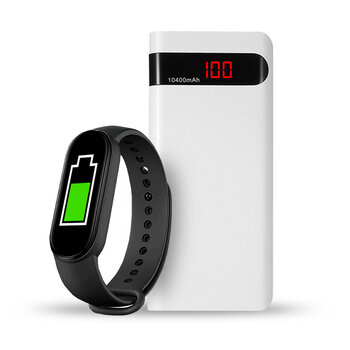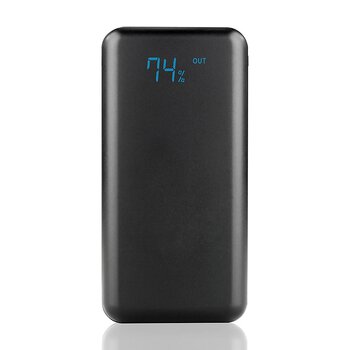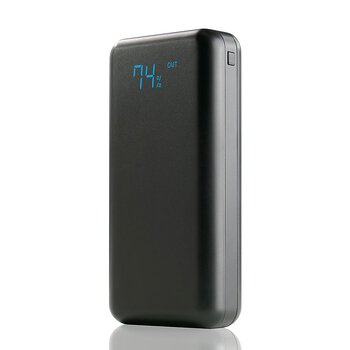- Tips
- technology
- Frequently Asked Questions
- Tests
- mAh capacity
- Rated Capacity
- everActive
- comparison
- Durability of rechargeable batteries
- Efficiency of rechargeable batteries
- battery voltage
- Accumulated energy
- Batteries vs rechargeable batteries
- LR03 AAA
- LR6 AA
- eneloop
- AG13 LR1154 LR44
- Delta V
- Charge Cycles
- internal resistance
- charge level
- CR 2032
- memory effect
- accredited test
- SR44 357
- Hearing Batteries 675
- SR626 377
- Watch Batteries
- Polarity
- Mah
- passivation
- LS 14250
- LS 14500
Power banks and smart bands - why is it difficult to get 100% charge with a power bank?

First of all, the behavior described above does not mean a defect in the power bank. From our other -->>post<<-- you already know that the energy that goes from the powerbank to our portable devices is largely processed - it does not go directly from the battery integrated in the powerbank.
Each power bank has different safety and energy saving mechanisms implemented.
Manufacturers of branded power banks also care about the high efficiency of their devices, so that as much energy as possible can be used by the end user.
It would be unwise for our power bank to remain on all the time, regardless of whether it is currently in use or not. After all, turning it on means turning on the internal converter, which immediately starts to slowly discharge the battery in the powerbank. Therefore, it is necessary to automate the entire process - to determine when the powerbank (its converter) should turn on and when it should turn off.
How do I determine when the power bank should disconnect charging?
The answer seems very simple - when our connected device is charged! Well, that's the main assumption, but what does it really mean for a powerbank to fully charge a connected device? We will explain this using a typical example when we try to charge a phone - a smartphone - with a power bank.
- We plug in the phone to charge (without turning it off).
- In a typical scenario, our phone reaches 100% charge, after which the power bank turns off - so everything seems to be fine, right?
But on the other hand, why did the power bank turn off? - after all, the phone remains on and still needs some energy to maintain the charge - when it is connected to the wall charger, full 100% charge is maintained until we disconnect it from the charger. Why doesn't it work this way in most power banks?
From the power bank side, it simply does not pay off in terms of energy. When the load on the USB output drops below a certain level, a relatively large amount of energy in the power bank begins to be simply wasted on the operation of the internal converter. Therefore, virtually all manufacturers have adopted the principle that when the load on the power bank drops below a certain level, it is considered that the connected devices are practically charged and the charging can be disconnected.
In practice, it is most often the case that when the current consumed by our device drops below ~50-80 mA, the output of a typical powerbank is deactivated.
A charging termination current of 50-80 mA will be a full charge of virtually all devices with batteries above 500 mAh.
However, our smart band or other small mobile device often has a battery with a capacity of 100 mAh. Such devices are often charged with low current, usually not exceeding 100 mA, and sometimes even lower. In addition, the charging characteristics of a lithium-ion (Li-ion) battery cause the charging current to drop significantly when the battery reaches ~75-80% charge.
This mentioned charging current of 100 mA is already very close to the threshold at which most power banks disconnect charging - in such conditions we have no chance to fully charge our smart band and charging will very often end at 80-90% charge, as soon as the charging current drops to ~50-80mA. This is completely normal and, contrary to appearances, also beneficial for our portable device - Li-ion batteries charged to about 80% charge age much slower than when they are charged to 100% each time.
However, if our charging device requires electricity below 50 mA, it is highly likely that the power bank will turn off after just a few minutes. several seconds.
The described observation applies to the vast majority of power banks available on the market.
Some models of power banks have more advanced automation and can charge better with low current, and even work to a certain extent to maintain full charge of devices.
There are also models that have a separate mode/output for charging devices with low energy demand - if in doubt, it is worth asking the seller about this aspect.
How can we deal with such a situation?
The simplest method is to charge small portable devices together with another device (phone, etc.) - most power banks nowadays have more than one USB output. The additional load on the power bank will also cause our small accessory to be properly charged, even if it has low energy requirements itself.
Power banks available in the hurt.com.pl store
Power Bank (powerbank) everActive Energy Bank EB-L20k 20000 mAh
high-quality lithium polymer battery
iQ Smart Charging technology - built-in advanced chip automatically detects the connected device and charges it with the maximum current suitable for it
high performance - fast charging of 2 devices at once
output: 2 x USB DC 5V / 2A max.
Input: 1 x micro USB DC 5V / 2A
Input: 1 x USB-C DC 5V / 2A
clear LED display
capacity 20000mAh - guaranteed
compact powerbank dimensions and light weight of 416g
Author: Michał Seredziński
Copying the content of the text or its part without the consent of a representative of Baltrade sp. z o.o. is prohibited.
-
Dzień dobry.
Mam tablicę do kalkowania którą się podłącza do laptopa. Tablica ma 3 tryby świecenia słaby średni i wysoki. Po podłączeniu do laptopa wszystko jest ok, świeci we wszystkich trybach. Po podłączeniu powerbanka w trybie słabym powerbank się wyłącza po 30 sekundach. Podłączenie drugiego zestawu nie wchodzi w grę by dodatkowo obciążyć powerbank . Chciałbym żeby powerbank obsługiwał wszystko. Jaki powerbak powiniem zakupić.
Z góry dziękuję za odpowiedź. Pozdrawiam serdecznie-
Ta tablica pobiera zapewne znacznie poniżej 80-100 mA podczas pracy. Typowy power bank taki pobór prądu oceni jako koniec ładowania podłączonego urządzenia i w celu oszczędzania energii odłącza wyjścia. Rozwiązaniem są albo power banki z dedykowanym wyjściem niskoprądowym lub modele o możliwie niskim progu odłączenia.
Niestety rozwiązania z dedykowanym wyjściem niskoprądowym są bardzo niepopularne i obecnie trudno nam wskazać sprawdzony model, który by taką możliwość oferował.
Rozwiązaniem bardziej uniwersalnym są power banki, które w standardzie mają ten próg ustawiony możliwie nisko - tutaj możemy wskazać modele everActive EB-L10k oraz EB-L20k - tam wyłączenie wyjścia nastąpi dopiero gdy natężenie spadnie w okolice 30 mA. Czy to wystarczy w tym wypadku - trudno powiedzieć bez większej ilości szczegółów dot. tej tablicy, jednak to jedne z najniższych wartości z jakimi się spotkaliśmy.
Jak już znajdziemy odpowiedni power bank do pracy w takich warunkach to efektem ubocznym będzie prawdopodobnie niska efektywność pracy z tak niskim obciążeniem (niższa niż spodziewana użyteczna pojemność) oraz nieprawidłowe wskazania stopnia naładowania naszego power banka.
-

